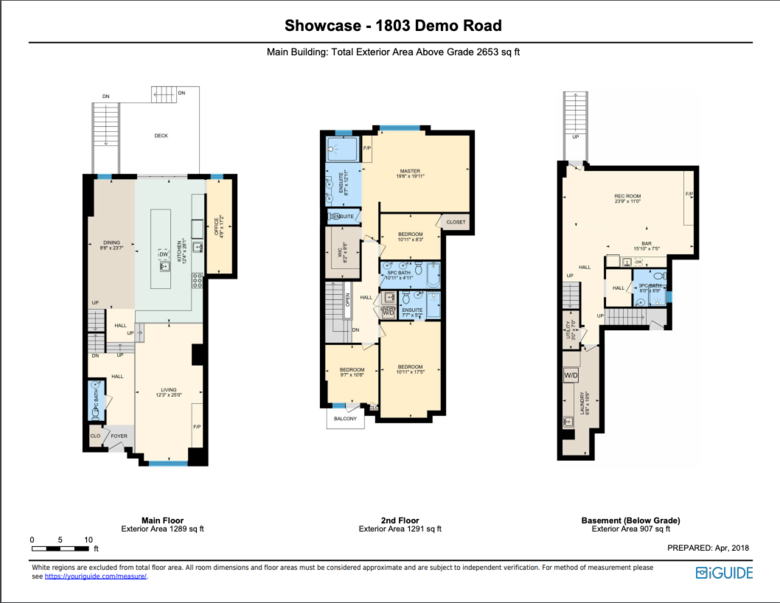Are Matterport, iGuide and Metareal 2D floor plans equal in accuracy?11395
Pages:
1
 WGAN Forum WGAN ForumFounder & WGAN-TV Podcast Host Atlanta, Georgia |
DanSmigrod private msg quote post Address this user | |
| Hi All, Matterport, iGuide and Metareal all offer 2D schematic floor plans from their 3D virtual tours. Are Matterport, iGuide and Metareal 2D floor plans equal in accuracy? (And, does this matter?) Dan P.S. This question is inspired by this WGAN Forum discussion: ✓ I need help choosing a 3D Virtual Tour Platform for by Real Estate Listings |
||
| Post 1 • IP flag post | ||
 iGUIDE iGUIDEFounder/CEO Kitchener, Canada |
Alex_iGuide private msg quote post Address this user | |
 See PDF floor plans Dan knows well how to ask provocative questions. The thing is that when people look at a floor plan, they see it as an engineering drawing with the implicit assumption that it resulted from a rigorous measurement process. And so they expect it to be reliable, with all walls and angles between walls shown correctly and any provided dimensions or square footage being accurate. Ultimately, the end result depends on the measurement technology used and the drafting process. All floor plan drafting currently involves a human factor and is not 100% automated. I can speak about how the iGUIDE technology ensures those expectations are met. The iGUIDE IMS-5 camera uses a time-of-flight lidar where measurement accuracy is constant with distance (1cm in measured distance to a wall). Whether a wall is 3ft(1m) away or 30ft(10m) away (our lidar range is 30ft) it will still be the same measurement error. So, the measurement error expressed as % of measured distance actually gets smaller for larger distances with ToF lidars. Since the lidar measures outlines of individual rooms, when the rooms are stacked together to form a floor plan, those errors may add up. Say, for 5 rooms on a typical house floor plate with 10m length, the worst case error would be 5cm or only 0.5%. In reality, a single scan taken in a hallway that can go from one exterior wall to another will allow to have only 0.1% error across the entire floor plate. Technologies that rely on structured light (e.g. Matterport) or photogrammetry/structure from images (e.g. any 360 camera platform) use triangulation where distance is computed from two angles and a baseline. With triangulation, the measurement error expressed in ft/m grows quadratically with distance and it grows linearly if expressed as % of measured distance. To control that runaway error, it is better to use more camera positions per room, so that they are spaced closer together. Our old IMS-4 camera used triangulation principle as well where a red laser line was projected horizontally on walls and was imaged by a DSLR. That camera would often get out of calibration due to a strong bump or big temperature swing and an infield calibration procedure had to be used by a photographer to bring it back in spec. Our experience has been that floor plans accuracy matters. Back when we used the IMS-4 camera, agents would complain that provided room dimensions differed from what they measured themselves with a tape measure and dealing with those issues was a big headache. In 2016 the province of Alberta in Canada mandated Residential Measurement Standard (RMS) that prescribed exactly how a property needs to be measured in order to compute its square footage (they call it RMS size) and disallowed using square footage taken from tax records. Similarly, in Ontario agents are not allowed to publicly display on listings square footage taken from the tax records. In the US, North Carolina also has a prescribed set of guidelines for measuring properties based on ANSI Z765 standard and prohibits use of tax records for square footage. In 2017 Alberta amended the RMS to include the requirement that square footage error must not exceed 2%. Incidentally, BOMA standards for commercial spaces also mandate 2%. Now, that means that linear measurement error on floor plans cannot exceed 1%. With the iGUIDE IMS-5 camera providing 0.5% accuracy or better, there is lots of headroom, so that everyone can sleep well, since square footage accuracy can be a very litigious area. |
||
| Post 2 • IP flag post | ||
 Metareal MetarealCo-Founder Montreal CAN |
gareth private msg quote post Address this user | |
| Hi Dan, Excellent question. Using Metareal Stage, users can make tours from any kind of equirectangular panorama. The precision of the results essentially depends on the quality of the source imagery, size of the space. Here's an example tour: As an expert user with a high-quality 360 camera (such as a Ricoh Z1) you should expect area accuracy within 2% of ground truth. As Alex mentions, 2% area accuracy is typically considered BOMA compliant (http://bomacanada.ca/resources/standards/). (Note also that Metareal area calculations use the BOMA Method B, or Net Method.) We sometimes suggest that users relying on precise dimensions take a couple of laser measurements during shooting to compare with the tour's final dimensions and make sure the end results are accurate. And, unlike typical photogrammetry/SFM based approaches, it is possible to correct most errors directly in the Metareal Editor. All that said, Metareal certainly isn't a lidar system. But it's also fast and very affordable, so it really depends what you need. Here is a link to an example floorplan: https://drive.google.com/file/d/11_vGQAcwYaf2uGwL8GerPMGrenAXWlxY/view cheers! Gareth |
||
| Post 3 • IP flag post | ||

|
bryanhscott private msg quote post Address this user | |
| @DanSmigrod As I am sure you already know, notwithstanding the .5% to 2% accuracy range referenced so far in this string, other more manual floor plan apps (i.e., Cubi.Casa, among few others) allow you to use their app to create your floor plans, then in the dashboard of the app, make changes to dimensions by inputting actuals taken on site with a tape measure. Captur3d, also allows the service provider to submit dimension changes (based on actual), but it adds more time to the delivery. | ||
| Post 4 • IP flag post | ||
Pages:
1This topic is archived. Start new topic?
















